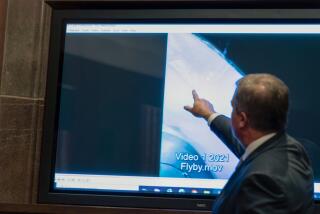Coming Out of Hiding
The National Aeronautics and Space Administration, accustomed to basking in the glory of success, is hardly distinguishing itself in adversity. In the aftermath of the explosion of the Challenger and loss of its seven-member crew, NASA seems to have forgotten its policy of openness and accessibility, which has been one of the hallmarks of the American civilian space program from its earliest days.
NASA’s personality changed shortly after the Challenger disaster on Jan. 28, when it impounded film from news photographers’ cameras near the launching site. If asked, nearly everyone would have cooperated with the space agency, but many people properly complained about the heavy-handed treatment. Under no circumstances does the government have the right to seize film.
The agency then clamped a lid on information and speculation about the cause of the shuttle disaster, instructing its employees to say nothing. As a result, virtually all that is publicly known about what might have happened to the Challenger has come from unofficial sources. NASA says it is concerned that speculation will be more misleading than informative and that it wants to wait until it has conclusions before discussing its findings. What it got for its trouble was grounds for those inclined to suspicion to think that it had something to hide.
The space agency did not volunteer that it was studying the possibility that the accident was caused by the failure of a seal on one of the shuttle’s solid-fuel booster rockets. It did not volunteer the history of its difficulties with seals on previous shuttle flights and internal memorandums calling attention to the problem. It did not volunteer the theory that the failed booster rocket had come loose and swung into the huge fuel tank beside it, setting off the explosion. It did not volunteer that it had fretted about the cold weather at the Kennedy Space Center before launching the Challenger and had discussed with the manufacturers the possible effects of the cold on the booster rockets’ solid fuel.
All of this has been reported through the press, and it’s a good thing, too. The information gave the members of the President’s commission investigating the accident a place to start questioning NASA officials. As it turned out, the officials were unprepared for the tough questions.
This is obviously a difficult time for the space agency. It has suffered the worst disaster in its history while under the helm of an acting administrator who was rushed into the job when the veteran administrator was indicted on a charge that had nothing to do with the shuttle. That helps explain the agency’s shift on information policy, but it does not excuse it. The good old ways are not always the best, but in the case of NASA’s open-door policy, they certainly were. The agency’s decision to make public its files on the booster rocket seals is more like the NASA we knew.
More to Read
Sign up for Essential California
The most important California stories and recommendations in your inbox every morning.
You may occasionally receive promotional content from the Los Angeles Times.










